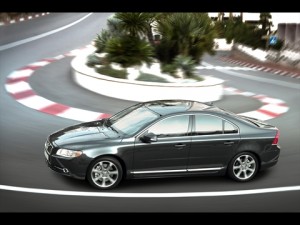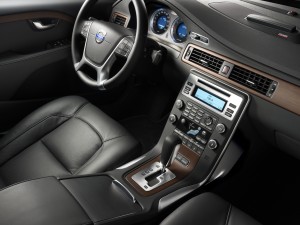
Has an unending quest to move upscale left Volvo without its more numerous core buyers?
Earlier this year, Volvo admitted that its European model range was not green enough. But now, with the new DRIVe versions, 80% of all Volvo models offered are green by the Swedish automaker’s own self definition of lowest CO2 emissions in the segment.
This has been achieved by adding to so-called green label models, DRIVe, which were introduced last year at the Paris auto show. The series started with the compact C30 that now can pass the lowest eco tax levels in Europe. Also the S40 and V50 with the 1.6-liter diesel engine were further improved with idle stop/start and brake energy regeneration.
During the Geneva auto show, four more DRIVe models were unveiled: the V70, S80, XC60 and XC70. They all have the 1.6-liter diesel motor with improved fuel efficiency and decreased CO2 emissions, so this is a marketing ploy based largely on one engine in multiple applications.
I have now had a chance to drive the new S80, which besides the improved 1.6 diesel model also gets a new D5 five-cylinder, twin-turbo diesel with 205 horsepower and 310 pound-feet of torque. The S80 D5 has a fuel consumption of 6.2 liters/100 km and emits 164 g/km CO2.

Volvo hopes to offer a less expensive alternative to its competitors from Mercedes-Benz and BMW.
The other new engine is the 2.0-liter diesel with 175 horsepower and also 310 pound-feet of torque with a fuel consumption of 5.8 liters/100 km and emissions of 154 g/km CO2. The current 2.0-liter diesel is unchanged. In June, the 109 hp 1.6 DRIVe diesel will be available on the European market for the S80 and V70. The diesel engines are not meant for the American versions of the S80, but the V-8 remains in the model range. And green claims there will have to come in some other guises.
Next year, Volvo will introduce a new 1.6-liter turbo engine that will debut in the upcoming new S60. Production has already ceased for the unloved current model sedan. The plug-in hybrid C30 is planned for a market launch sometime in 2012, badly behind Japanese offerings from Toyota, Lexus and Honda that have been on sale and refreshed and refreshed again for years now.
I drove the new S80 with the sports chassis model in the Cote d’Azur area in the south of France. After my with the standard “comfortable” set up I instantly preferred sport. The standard setup is a bit too soft for conquering the mountain roads connecting Nice to Monaco. But I am also aware that it is excellent for cruising and business drives with people in the rear seats.
Our car’s sports chassis was combined with all-wheel-drive and felt very stable when pushed aggressively. The improved steering gear that is part of the sports suspension package acts quicker and provides a better feel.
The sports chassis offering is new for the S80. In the United States, the outgoing model had a chassis biased toward comfort. In Europe it was tuned a bit stiffer. The U.S. spec chassis is now standard on the S80 in Europe, while apart from the sports chassis, there is another option that was already available, the electronically adjusting 4C chassis.
Although prices have not been announced for the renewed S80, European customers should expect them not to exceed 350-500 Euros over those of the outgoing one. For the North-American market the same will apply in dollars, so expect prices of the new S80 not be more than some $500-750 dollars higher when it goes on sale in the beginning of May. What the price increase will apply to is unclear. The 2009 S80 had a MSRP of $40,000 before options; It is currently being offered for $33,000.
With a more dynamic feel and improved looks of the S80,Volvo hopes to offer a cheaper alternative for its competitors from Mercedes and BMW. That is what Volvo used to do some time ago; and that is what could make the brand more successful in the future. The company could use a boost stateside where it has lost its way because of successful challenges to its safety positioning by Japanese makers who have added the latest electronic systems to their models. Volvo never was a serous contender in the European luxury segment. In the first quarter of 2009 Volvo sales declined 49% and struggling parent Ford Motor Company — facing its own 43% sales decline in Q1, on top of a stunning and record setting $14.6 billion loss in 2008 — is actively seeking to dispose of it.

I used to only drive Volvos. Then the 850-V70 replaced the 240-740. Loved my 850 until the headgskt went at 200k. Should not have been a big deal.everything else was fine and the headgaskt should have been a quick fix. On the 240-740 this is just not a costly repair. And when fixed on the 240 it stays fixed no problem. But with the 5-cylinder aluminum engine in the “new and improved” Volvo, this once simple repair is not possible. Noone even the best Volvo shops will even try anymore. They won’t stay fixed. So screw ’em. No more Volvos for me and my Volvo friends anymore. Most of us have gone to Subaru’s. Subarus are OK cars and better than Jeeps and they STAY fixed with simple and quick repairs.
All the while the Volvo decision makers wonder why they are loosing sales? It’s not the cupholders that killed Volvo. Its the reliability and the inability to fix the new engines that is causing them to loose their following. BTW I loved the mpg and the handling of the 850-V70. Just couldn’t keep it on the road cheaply. Bummer for me bigger bummer for Volvo.